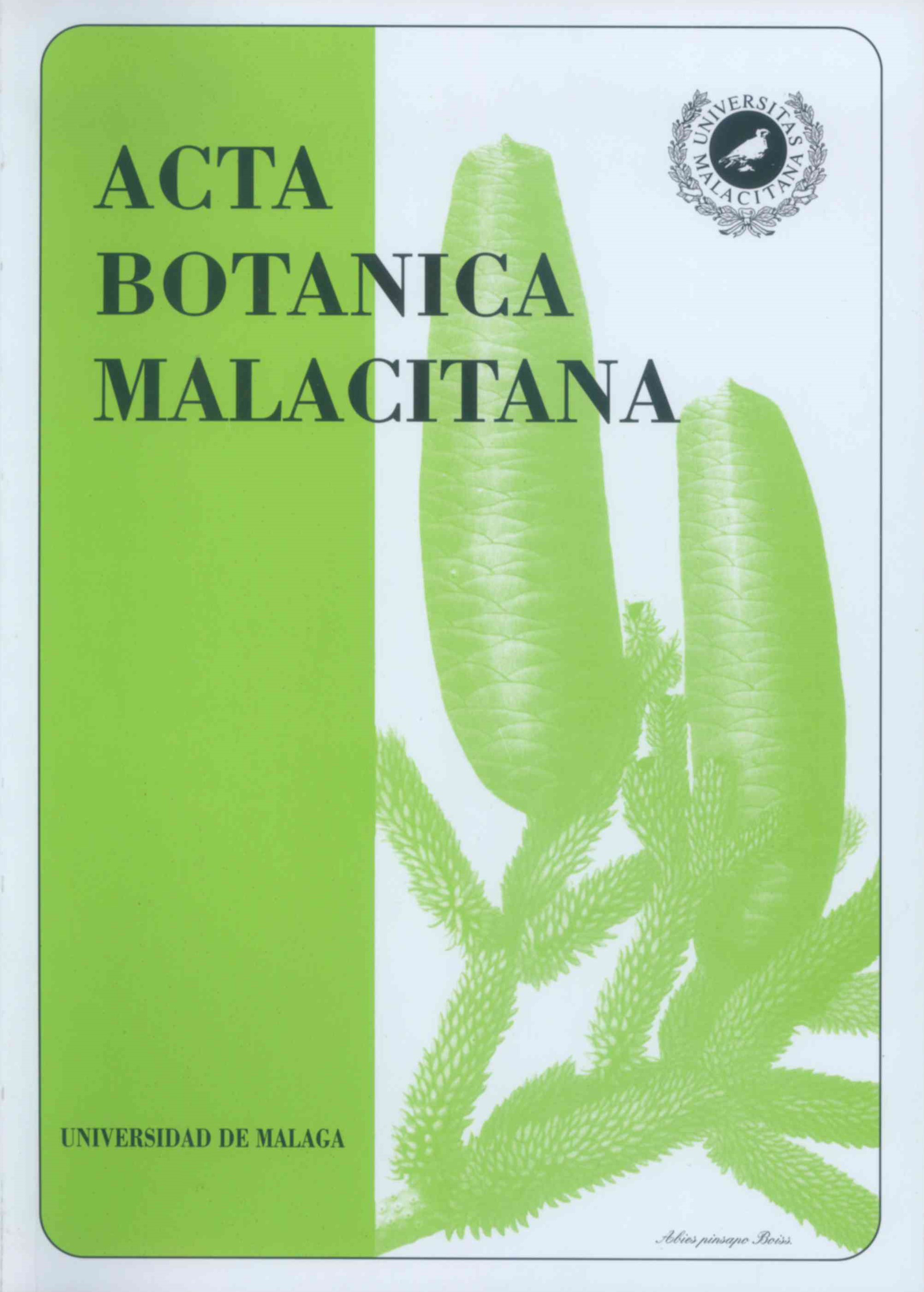Floral origin of the pollen loads collected by Apis mellifera L. in Abra (Malaga, Spain)
DOI:
https://doi.org/10.24310/abm.v15i.9293Keywords:
Melissopalynology, pollen loads, flowering phenology, Ma?laga, SpainAbstract
The microscopical analysis of the pollen loads collected by Apis mellifera during the pollen harvesting has shown 22 pollen types The familys Cistaceae, Fabaceae and Rutaceae are the main pollen sources in the studied zone. Data on flowing fenology, frecuency and floral resources have been relationed with the pollen analysis.
Downloads
Metrics
References
ANDERSON, E. & HUBRICHT, L. -1940- A method or describing and comparing blooming- seasons. Bull. Torrey Bot. Club, 67(8):639-648.
BONET JORNET, A., SEBASTIA ALVAREZ, M.T. & RITA LARRUCEA, J. -1984- La flora meli?fera de Barcelona. Vida api?cola, 12:10-1.
BONET JORNET, A., SEBASTIA ALVAREZ, M.T. & RITA LARRUCEA, J. -1986- Principales floraciones meli?feras de la provincia de Barcelona. Actas 11 Con gr. Nac. Apic., (Gijo?n, 1984):109-117.
ERDTMAN, G. -1960- The acetolisis method. A revised description. Svensk. Bol. Tiaskr.,54:501-504.
GOMEZ FERRERAS, C. -1986- Origen bota?nico del polen comercializado en Espan?a. Actas II Congr Nac. Apic. (Gijo?n, 1984):70-93.
GONZALEZ BENAVENTE, F. -1984- El polen api?cola espan?ol: composicio?n bota?nica y caracteri?sticas fisico-qui?micas. Actas 1 Congr. Nac. Apic. (Madrid. 1983): 31-44.
HOWES, F.N. -1953- Plantas nieliferas. Ed. Reverte?. Barcelona.
JEAN-PROST, P. -1989- Apicultura. Mundi Prensa. Madrid.
LOUVEAUX, J. -19586- Recherches sur la re?colte du pollen par les abeilles (Apis mellifera L.). Ann. Abeille I (III): 113-188.
LOUVEAUX, J. -1958c- Recherches sur la re?colte du pollen par les abeilles (A. mellifera L.) (suite). Ann. Abeille I (IV): 197-221.
LOUVEAUX, J., MAURIZIO, A. & VORWOHL, G. -1978- Methods of melissopalynology. Bee world, 59(4): 139-157.
MAURIZIO, A. & LOUVEAUX, J. -1967- Les me?thodes et la terminologie en melisopalynologie. Rev. Paleobot. Palynol., 3:291-295.
PERCIVAL, M. -1947- Pollen collection by Apis mellifera. New Phytol., 46-142-173.
PERCIVAL, M. -1950- Pollen presentation and collection New Phytol., 49:40-63.
PERCIVAL, M. -1955- The presentation of pollen in certain Angiosperms and its collection by Apis mellifera. New Phytol., 54:353-368.
REITSMA, T.J. -1969- Size modification of recent pollen grains under different treatments. Rev. Paleobot. Palynol., 9:175-202.
SALA LLINARES, A. -1948- Plantas meli?feras de la zona de Jijona (Alicante). Vida apicola, 11:52-56.
SAURY, A. -1981- Plantes melliferes. Ed. Lechevalier. Paris
SERRA, J. -1988- Origen bota?nico del polen api?cola producido en Espan?a. Anales Asoc. Paolinol. Lengua Esp.: 4:73-78.
SERRA, J., GONELL GALINDO, & GOMEZ PAJUELO, A. -1986c- El polen de abeja producido en Espan?a. Vida api?cola, 19:35-38.
SHARMA, M. -1970- Analysis of pollen loads of honey bees from Kangra, India. Grana, 10:35-42.
SHWAN, B. & MARTINO, S. -1954- Studier over binas (A. mellifera) pollen drag i Ultuna. Statens Hudsjursffirsiik Medelande,: 57.
SYNGE, A.D.-1947- Pollen collection by honey bees (Apis mellifera). Journal Animal Ecology, 16:122-138.
TALAVERA, S., HERRERA, J., ARROYO, J., ORTIZ, P.L. & DEVESA, J.A. -1988- Estudio de la flora api?cola de Andaluci?a Occidental. Lagascalia, 15 (extra): 567-591.
VALDES, B., DIEZ, M.J. & FERNANDEZ, I. -1987- Atlas poli?nico de Andaluci?a Occidental. Inst. Des. Regional y Excma Diputacio?n de Ca?diz. Sevilla.
VERGERON, P. -1964- Interpretation statistique des re?sultats en matiere d'analysis pollinique des miels. Ann. Abeille, 7(4):349-364.
VISSHER, P.K. & SEELEY, T.D. -1982- Foraging strategy honey bee colonies in a temperature deciduous forest. Ecology, 63(6):1790-1801.
Downloads
Published
How to Cite
Issue
Section
License
All information related to the licensing of published works in Acta Botanica Malacitana and copyright can be found in our Editorial Policy.







1.png)
